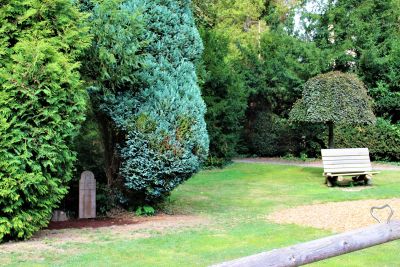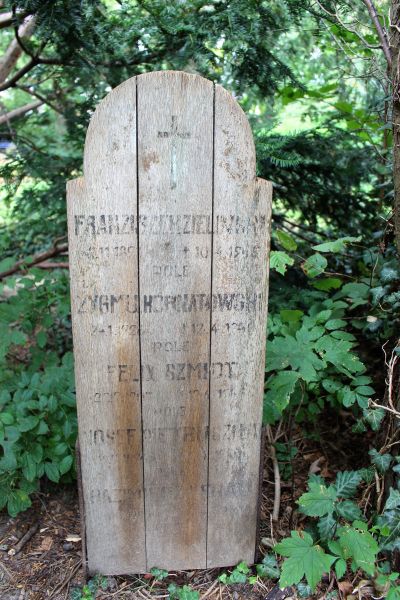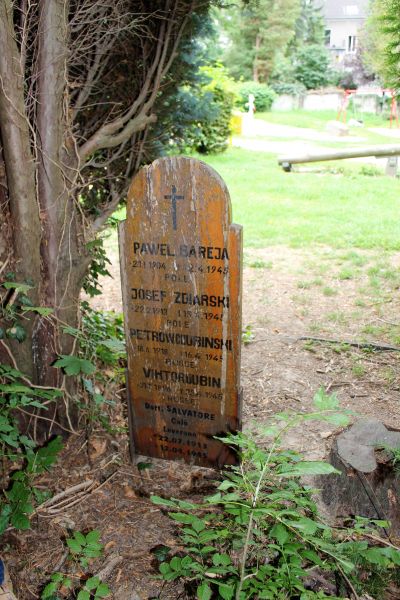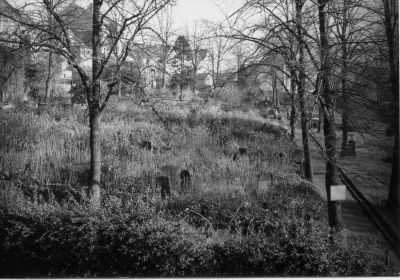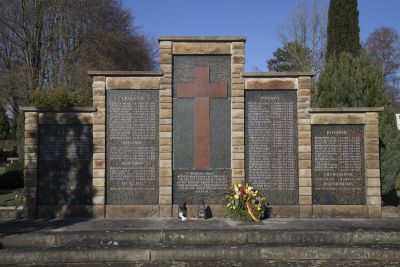THE TEN FORGOTTEN FACES IN THE PARK
A list of graves under Section 5(1) of the Burial Act of 1 July 1965 for publicly tended graves in the administrative district of Arnsberg contains a “collective grave” listed as being 8 m² and housing “more than 10 civilians (foreign workers), who died whilst working in Germany in the Second World War”. This list of graves was signed by Wetter’s municipal director Willi Reiber on 16 November 1970. Graves of this kind are permanent and are to be cared for and maintained by the respective states and local authorities for which the federal government assumes the costs.[2] The site with its old headstone lies hidden under tall conifers in a small park in the heart of the small town.
Sunlight has increasingly faded the five inscriptions on the wooden headstone and made them hard to read:
1 Franziszek Zielinski, born 3 November 1891, died 10 April 1945
2 Zygmund Kornatowski, born 24 January 1926, died 12 April 1945
3 Felix Szmidt, born 17 June 1907, died 12 April 1945
4 Josef Pietruszka, born 19 March 1896, died 12 April 1945
5 Kazimierz Legau, born 4 April 1904, died 12 April 1945
In each case, the nationality “Pole” has been added next to the birth and death dates which are barely legible.[3] (Fig. 2)
If you make your way through the undergrowth and rubbish, you will find five more inscriptions on the back of the headstone, two of them again being Poles. They are:
1 Pawel Bareja, born 23 January 1904, died 12 April 1945
2 Josef Zdziarski, born 22. February 1913, died 15 April 1945
All seven Poles hailed from Warsaw and its surrounds. Their professions were listed as “labourers”, both on the Arnsberg list of graves and on the death certificates. When they died, the oldest was 54 years old (Franziszek Zielinski), the youngest only 19 (Zygmund Kornatowski). All were Catholic, the youngest was still unmarried; the names and places of residence of the wives of six of the Poles were given on the death certificate as “unknown”. Presumably, no attempt was made to find relatives – not even the parents of the youngest victim.
The three other people interred there are:
3 Petrow Chubrinski, born 18 June 1918, died 16 April 1945
4 Victor Dubin, born 31 January 1896, died 13 April 1945
5 Dott. Salvatore Calò, born 22 July 1913, died 12 April 1945[4]
Petrow Chubrinski, native of the Ukraine, was also listed as a labourer, Victor Dubin from Stalingrad was a camp warden. Both were registered as having no religion. Dottore Salvatore Calò, Catholic, hailed from Leverano. Friends did not add the name, profession and title, date of birth and place of origin of the 32-year-old Italian doctor to the wooden headstone until long after his death.[5] (Fig. 3)
Many of the dates on the headstone do not correspond to the archive material. There are also discrepancies between the death certificates, list of graves and an older publication of the former municipal archivist. In this case, with the exception of Salvatore Calò, the author refers to the death certificates because the migration of the working foreigners was officially registered.
[1] The town is proud to be associated with the life and work of the important industrial pioneer Friedrich Harkort, who, more than 200 years ago, founded the Mechanische Werkstätte Harkort & Co high above the river, which would later merge with the Deutsche Maschinenbau Aktiengesellschaft (DEMAG);
cf. Struchtemeier, Thea: Die Stadt Wetter an der Ruhr ist eine Wiege der Industriekultur – Ein Rundgang in der Freiheit, in: Lokalkompass.de, 15/5/2019, https://www.lokalkompass.de/bochum/c-kultur/die-stadt-wetter-an-der-ruhr-ist-eine-wiege-der-industriekultur-ein-rundgang-in-der-freiheit_a1136025; (last accessed on 11/10/2021).
[2] For the perpetual right to a resting place for victims of war and tyranny (Graves Act), see especially Sections 1, 2, and 10.
[3] Because the panels were so weatherbeaten, the author consulted the death certificates in the Wetter/Ruhr municipal archive for the correct birth and death dates.
[4] The death certificate for the Italian doctor Salvatore Calò is incomplete stating, “First name unknown”. Indeed, the surname was unknown and was later amended, see more Note 5.
[5] Görzel, Klaus: Fünf Mal “Herzschwäche” an nur einem Tag, Westfalenpost, 18/11/2014.
What were seven Polish men and three other men from Italy and the Soviet Union doing in Wetter an der Ruhr in 1945 to lose their lives there?
On 1 September 1939, shortly after the invasion of Poland and the beginning of the Second World War, the German armaments industry was already in need of a large workforce. The locals, who had been sent to the front, were to be replaced by a foreign civilian workforce, recruited with increasing brutality, and by prisoners of war[6]; this was also the case in Wetter. A letter from the Reich Ministry of Labour dated 9 October 1939 informed the town for the first time that it was to use prisoners of war in agriculture and forestry; Ennepe-Ruhr-Kreis was already expecting its first Polish prisoners of war on 13 November 1939 and made rapid preparations to house them and to create sanitary facilities, surveillance, pillows made of straw and the perimeter fencing with barbed wire – there were no iron locks due to the lack of raw materials –, so that “from the outset, there is no possibility of direct interaction with the population”.[7] Three months after the start of the war, a quarter of a million Polish prisoners of war were deployed in the German Reich and around 30,000 Polish civilian workers, predominantly women.[8]
Working prisoners of war in Wetter were initially housed in venues that had been seized (for example “Bauer‘scher Saal Camp”, “Düllmann’scher Saal Camp”), but were later placed in specially erected barrack camps (like those in Oberwengern). Companies like the DEMAG public limited company, the Carl Bönnhoff steel foundry, the Ludwig Bönnhoff steel foundry, the Mark A.G. steel foundry, the Carl und Walter Prinz drop forge and file factory, the Harkort-Eicken Hagen steel foundry headquartered in Wetter, the Geis construction company and the town of Wetter itself requisitioned prisoners of war, as did Lindackers dye works and chemical cleaning company. The companies and the town contributed to the costs of the camp, and small businesses from Wetter issued invoices for food, washing services, office supplies (camp stamp), blackout papers, medication and more.[9]
It is against this background that those ten men also arrived in the Ruhr area. The seven men from Poland were accommodated in a camp (house) in Kaiserstraße 56. According to Hagen address books, ten years previously this accommodation had housed a Catholic citizens’ association and club house, a castellan and a milliner, and must not have been far from the Catholic parish church of St. Peter and Paul. The innkeeper Wilhelm Dröge was registered at this address from 1938 to the 1950s, with a “waitress” being added in 1941/42.[10] The other three men were assigned to other sites: The Ukrainian to the Düllmann‘scher Saal camp in Schöntaler Straße 40, the Russian from Stalingrad to the camp belonging to the Bönnhoff companies in Wittener Straße 2 and the Italian doctor to the large DEMAG camp in Oberwengern.[11]
In the last days of the war, the industrial town of Wetter was subjected to heavy artillery fire by the Americans. As well as private residences and the hospital, the camps housing prisoners of war and forced labourers were also hit. Five of the Poles listed on the wooden headstone died at midnight on 12 April 1945 when Kaiserstraße 56 came under fire, two other Poles who were also registered there were killed in other violent circumstances – the 54-year-old two days prior and the 32-year-old three days later. The Italian doctor from the Oberwengern camp was also killed late in the evening of 12 April 1945 by shrapnel when he was providing assistance in the Düllmann’scher Saal camp. The 27-year-old Ukrainian died before daybreak on 16 April 1945, three days after the surrender of Wetter, from serious gunshot wounds which he had received “for looting”.[12] The food shortage and consequently the severe hunger in Wetter has been described a number of times by the war chroniclers of the time; there was also a curfew from 6.00 p.m. to 8.00 a.m. According to the appeal made by the interim Mayor Lorek on 14 April 1945, the people of Wetter were also responsible for catering for the “the foreign workers”.[13] The Russian camp warden in the Wittener Straße 2 camp also only survived the town’s defeat by a few hours: According to his death certificate, his fellow countrymen wreaked a bloody revenge on him.[14]
They must have been chaotic, hectic days in Wetter: On 13 April 1945, it was surrendered to representatives of the American troops. The camps for prisoners of war and forced labourers were disbanded and all those who had been kept in subjugation freed themselves and demanded bread and rights. The losers were worried and hurriedly destroyed incriminating documents.
The town of Wetter buried many of those forced labourers killed in the new cemetery (today: Park der Ruhe, Gartenstraße) and the Evangelical Cemetery in (Wetter-) Wengern. The seven Poles from the wooden headstones who had lost their lives in the last days of the war found their final resting place with the Italian, the Ukrainian and the Russian two streets away in the old Wetter cemetery. On 14 June 1945, Mayor Lorek revoked the ‘out of use’ order of 2 August 1941 and decided to allow the site in Bornstraße to be used for burials again.[15] This means that the collective grave of the ten dead men was erected two months at the earliest after the deadly events in April. (Fig. 4)
[6] They were required to work under the Geneva Convention of 1929 and could be requisitioned through local employment offices.
[7] See Wetter/Ruhr municipal archive.
[8] Mentner, Regina: Die Beschäftigung von Zwangsarbeiterinnen und Zwangsarbeitern für Aufgaben des “alten” Ennepe-Ruhr-Kreises, Schwelm 2002, p. 6; https://www.enkreis.de/fileadmin/user_upload/Dokumente/01/dokumentationzwangsarbeit.pdf (last accessed on 11/10/2021.)
[9] See correspondence between Lindackers and the town of Wetter/Ruhr, 9/9/1940; Agreement between the companies and Mr Walter Düllmann (Camp) 22/5/1941, 4/2/1943; invoices paid to the Düllmann prisoner of war camp in the period from 1/1 to 17/3/1943; Wetter/Ruhr municipal archive.
[10] Address books from the town of Hagen with entries from the town of Wetter from 1934, 1938, 1941/42, 1951; Wetter/Ruhr municipal archive. See also local reference to the Dröge restaurant in: Thier, Dietrich (Publ.): Die Kriegschronik der Stadt Wetter (Ruhr) von Gustav Ebert. Veröffentlichungen des Stadtarchivs Wetter (Ruhr) (Vol. 2), Wetter (Ruhr) 2000, p. 249.
[11] There are said to have been 1210 prisoners of war and forced labourers in the Oberwengern camp; there were Italian prisoners of war, “Eastern and Western workers” (forced labourers) and families with infants and children; see: Thier, Dietrich: Kriegsgefangenen- und Fremdarbeiterlager in Wetter (Ruhr) zwischen 1939 und 1945, in: Kniehase, Hans-Friedrich / Thier, Dietrich (Publ.): PROJEKTE. Landeskundliche Studien im Bereich des mittleren Ruhrtales. Schriftenreihe der Friedrich-Harkort-Gesellschaft Wetter (Ruhr) und des Stadtarchivs Wetter (Ruhr), Wetter (Ruhr) 1996, p. 225–229.
[12] Death certificates, Ruhr municipal archive. The 32-year-old had been shot from behind two days after the town had surrendered. According to Thier (1996), “heart failure” always indicates an “unnatural death”, see p. 71, 229, 231. Inhabitants of Wetter remembered the last days of the war in the Westfalenpost, for example 11/4/2021, 23/4/2021.
[13] Regarding hunger in the town, see also: Die Kriegschronik der Stadt Wetter (Ruhr)(2000), passim, also p. 209f.; der Aufruf ibid., p. 202.
[14] The town’s list of graves presumably contains a transcription error (typing error).
[15] Revoking of the ‘out of use’ order of the old cemetery (Bornstraße), see war chronicle of Wetter (Ruhr). Upon enquiry, the Volksbund Deutsche Kriegsgräberfürsorge (Münster) is not aware of any memorial which is directly next to and not zoned off from various play equipment. Only in Ysselsteyn (NL) is there a youth centre close to the war graves site which is, however, separated by a fence and a row of trees. Under the Graves Act, victims of war and tyranny have an unrestricted right to a resting place. The playground was opened again on 10 June 2019 after renovation work without taking the war graves site into consideration; cf. https://www.wetter-ruhr.info/2019/07/spielplatz-alter-friedhof-wird-am-mittwoch-wiedereroeffnet/ (last accessed on 11/10/2021).
The forced labour sites in Wetter/Ruhr as places of remembrance
In the period between 1939 and 1945, there were numerous camps for prisoners of war and forced labourers in Wetter, even some for women, families and children. Wetter companies registered a high demand for foreign workers for their industries, as did the town of Wetter. The working and living conditions of those interned were controlled, restricted and inhuman. The way they were paid and fed was based on a racist hierarchy: “Eastern workers” received the lowest wage and the least food.[16] Between 25 April 1942 and 29 June 1945, more than 75 forced internees died in Wetter.[17] Since then, the municipal archive has established that there were further deaths of people who were not directly registered in the register of deaths and whose fate was not established until after the war had ended. The last entry of a deceased prisoners of war was made in May 1966.[18] The many young people from abroad, who lost their lives in Wetter in 1939 and 1945 in the face of totalitarian conditions, had an identity without a future. Historically and ethically, the town has an obligation to commemorate this period when injustices were suffered and tyranny endured and to enshrine this in its civic work on culture and education. Some of the companies in which the many workers from abroad slaved away still exist today. Some of the camps in which they whiled away their meagre free time have had new homes built over them. The streets still exist but today there is nothing there to show that these were the places were injustice occurred and tyranny was endured. Only the isolated town cemeteries show signs of a topography of past terror which are visible to the public but which are often unfamiliar to future generations. Historical remembrance also has an increasingly important role to play in good generational ageing, how and what people remember and their own self-awareness in the process.[19]
In September 2019, with the aim of commemorating the specific circumstances of forced labour in Wetter and to bring it into the public arena, the author brought a proposal to the city council stating that the care of grave sites from war and violence should not be neglected, the dead (where possible) should be given back their names comparable to other war dead, and information boards showing the historical background should be erected at the grave sites; likewise, wherever there had been camps and places for prisoners of war and forced labourers, signs with historical references should be attached as a memorial to the fate of these multiethnic, workers in the industrial town.
According to the council decision of 22 October 2019, during an on-site visit with the LWL-Denkmalpflege, Landschafts- und Baukultur in Westfalen and at the “Memorial to the forced labourers; Old Cemetery in Bornstraße”, the “heritage value within the meaning of the heritage protection law was recognised”. On 12 December 2019, the town council unanimously agreed to the author’s proposals and decided the following: “1. Management is tasked with finding multiple suitable sites in the city area in which reference can be made to the history of the forced labour camps. 2. Management is requested to make contact with the Polish Consulate again and to convey the request of the Wetter (Ruhr) town council for permission for a dignified reworking of the headstones in the Bornstraße cemetery”.
As of October 2021, the decisions have not be implemented. What is more, in the summer of the same year, the wooden headstone of the ten deceased men under the conifers disappeared, which has now been located by the author in municipal facilities.
A continuation of the remembrance work in Wetter will follow.
Thea Struchtemeier, October 2021
[16] Fritzsche, Jörg: Zwangsarbeit in Hagen während des Zweiten Weltkriegs, Marburg 2005, p. 62–68.
[17] Thier (1996), p. 217.
[18] Draft resolution of the town of Wetter dated 14/11/2019.
[19] The journalist and author Sabine Bode interviewed a number of war children and grandchildren, who had been traumatised by their parents and grandparents not wanting to remember or not being able to remember; see also: Gutes Altern durch Erinnern see the project by Stefan Berger https://news.rub.de/studium/2021-07-30-unic-citylab-gutes-altern-durch-erinnern; (last accessed on 11/10/2021).
